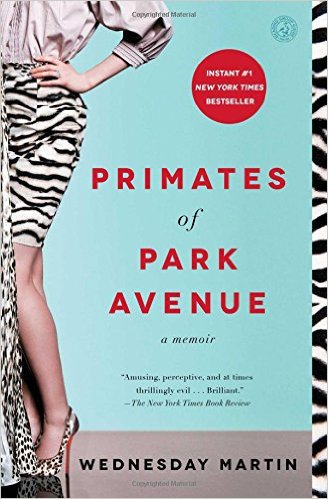
Primates of Park Avenue
Part biography, part anthropological commentary, in her book Martin describes her life in the most wealthy and affluent part of New York – Upper East Side Manhattan. Although she grew up in Manhattan herself, Martin finds herself thrust into a new way of life and with a new series of woes.
Unaccustomed to biographies, I found myself rather absorbed in the introduction before I even got to Chapter 1. Clearly the way of life in Upper East Side Manhattan seems remarkably different to life elsewhere. Even the least innocuous of encounters begins as a power-play. Individuals look at your clothes and assume everything about you before you even have your first conversation.
The book concentrates on the behaviors of mothers in the area. I don’t think this was done deliberately by Martin, but rather could be done no other way due to the implicit segregation of the sexes in the area. It is the males here who have the money and the power and this comes across. Meanwhile it is the job of the females to stay at home with the children and oversee family life.
Martin struggles to fit in with her new crowd at the beginning of the book, and her peers are depicted as arrogant and rude, making the newcomer feel unwanted and inadequate. The power plays began with her search for her ideal apartment, and later she endured awful acceptance rituals to get her child into a good nursery school.
In her quest for acceptance, Martin decides she needs an expensive handbag. Unfortunately (for most readers), Martin dedicates a whole chapter to her coveting and acquisition of said expensive handbag. I began to wonder if Martin had shares in Hermes. I became quite weary of the continuous reference to designer looks and accessories.
Later on in the book Martin uncovers the secret tensions and anxieties that plague the women she meets. Money doesn’t buy happiness it seems. The economic dependency on males is one factor. An economic dependency on parents and in-laws is another. Upper East Side mums are really under a lot of pressure to make sure their children do well. There are power struggles with the nannies. And finally there is self-medication with binge drinking and benzodiazepines.
Chapter 7 seemed to go off on a tangent where Martin broke into a lengthy description of the death of her unborn child and the following grief. But she goes back to the Upper East Side interactions saying she no longer had patience for the pettiness. To Martin’s surprise though, the other women became caring and considerate, confiding about their own losses, and showing that they understand.
I am sceptical about this seemingly happy ending however, and it crossed my mind that Martin may have hinted that she’d make individuals clearly identifiable in her book, so they would start treating her better before the book was published. Having read this real life account I remain repulsed at the behaviour of the Upper East Side community. I have no desire to even drop by let alone become one of them.
It was a mainly a pleasantly interesting read and Martin’s writing skills really come to the fore when she talks about the death of her child. It was not as entertaining as I had imagined it would be though. Maybe something you’d like to read on the beach, but not something I would read again.
Advertisements Share this:





